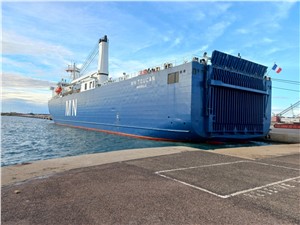Europe's New Weather Satellite Sets Sail
September 30, 2022
-The first of Europe’s Meteosat Third Generation satellites is now safely aboard a ship and making its way across the Atlantic to French Guiana where it will be readied for liftoff in December. Once launched into geostationary orbit, 36 000 km above Earth, this new satellite, which carries two new extremely sensitive instruments, will take Europe's leadership in weather forecasting to the next level.
The first Meteosat Third Generation Imager, MTG-I1, satellite plus 10 large containers of support equipment were loaded onto the MN Toucan cargo ship on 29 September and readied for the 12-day voyage to French Guiana.
On hearing that the precious cargo had left the port at Fos-sur-Mer, which is close to Marseille, Paul Blythe, ESA’s Meteosat Programme Manager, jokingly remarked, “I hope they know where Kourou is!”
Followed by, “Has anyone checked the weather forecast for the crossing and did anyone see Raffa (who is responsible for MTG-I1’s assembly, integration and testing) get off the boat?”
Everyone has subsequently been reassured that he did not stow away and will soon fly out to Kourou with the advance launch campaign team to meet this special shipment on the other side.
The shipment marked the end of an intense period of preparation at Thales Alenia Space’s facilities in Cannes where MTG-I1 had undergone final testing, integration and procedures to lock the parts of the satellite that will be deployed once it is in space such as the solar array and various antennas.
MTG-I1 carries two completely new instrument that will deliver high-quality data to improve weather forecasts: a Flexible Combined Imager and Europe’s first Lightning Imager.
The Flexible Combined Imager has more spectral channels and is capable of imaging in higher resolution compared to current Meteosat Second Generation’s Spinning Enhanced Visible and Infrared instrument.
The Lightning Imager offers a completely new capability for European meteorological satellites. It will continuously monitor more than 80% of the Earth disc for lightning discharges, taking place either between clouds or between clouds and the ground.
This new instrument will allow severe storms to be detected in their early stages and will therefore be key for issuing timely warnings. Its detectors are so sensitive that will be able to detect relatively weak lightning, even in full daylight.
MTG-I1 also carries two smaller payloads for data collection from remote science beacons and for search and rescue by detecting emergency beacons.
One of the last tests in Cannes involved the complex ‘compact antenna test range’ where a series of electromagnetic compatibility and radio frequency tests were carried out to ensure that no single part of the satellite disturbs or degrades any other part of satellite’s instruments.
Paul Blythe explained, “One particular requirement, which has been a major challenge throughout the design of the MTG-I1 satellite is to protect the highly-sensitive ultra-high frequency band of the Data Collection Service (DCS) and the Geostationary Search and Rescue (GEOSAR) instrument receivers.
“The satellite’s primary measuring instruments are the Flexible Combined Imager and Lightning Imager, but the DCS collects and relays data from buoys, ships and balloons, and the GEOSAR picks up distress signals for rescue services.
“To ensure the satellite receiver can detect the tiny signals sent by the search and rescue beacons, ‘emissions’ from the satellite must be kept really low to avoid swamping the signals from these life-saving devices.
“From the geostationary orbit, almost 36 000 km above Earth, the satellite has to detect miniscule signals from these small beacons, which generally emit less power than a domestic light bulb.”
The recent tests also involved having to demonstrate the sensitivity of the receiver despite all the background noise that occurs in the cleanroom. The result was a highly complex setup in an anechoic chamber with absorption cones that had been specially designed to ensure that any spurious signals in the critical ultra-high frequency band were attenuated.
Paul added, “The test was a complete success and we are confident that MTG-I1 will ensure continuity of this important humanitarian service currently served by the Meteosat Second Generation satellites.”
In parallel, the rigorous review process to ensure that the satellite is good to launch has been ongoing since early July. This concluded with the formal Qualification and Acceptance Review Board Meeting and the declaration that the shipment to Kourou could take place.
Eumetsat has also gone through a similar process for the ground segment, culminating in the Steering Board of the Launch and Operations Readiness Review, which also confirmed a maturity level that allows the launch campaign activities to commence.
Following a brief exchange between the ESA and Eumetsat, the formal consent to ship was given and green light confirmed to the boat.
MTG-I1 will spend the next 12 days crossing the Atlantic. When it arrives in French Guiana, this new satellite will be transported to Europe’s Spaceport and prepared to meet its rocket, an Ariane 5, with liftoff planned in December.
Source : European Space Agency (ESA)


